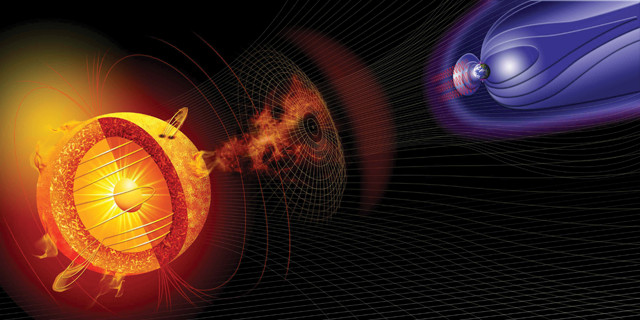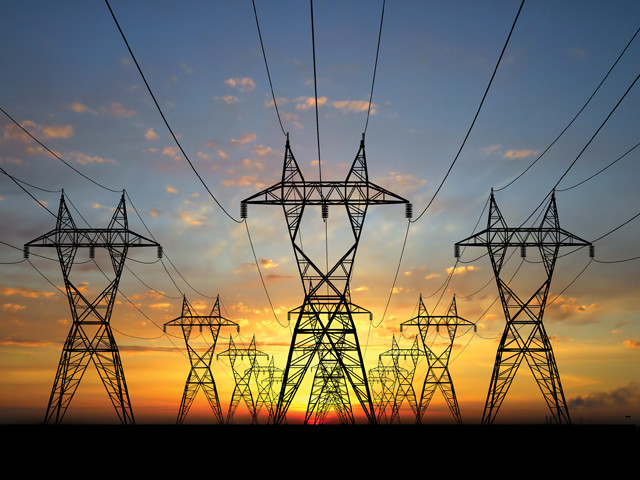
by Jeffrey J. Love Friday, February 5, 2016

Artist's conception of a solar storm affecting Earth's magnetic field. Credit: NASA.
Extreme space-weather events — intense solar and geomagnetic storms — have occurred in the past: most recently in 1859, 1921 and 1989. So scientists expect that, sooner or later, another extremely intense spaceweather event will strike Earth again. Such storms have the potential to cause widespread interference with and damage to technological systems. A National Academy of Sciences study projects that an extreme space-weather event could end up costing the American economy more than $1 trillion. The question now is whether or not we will take the actions needed to avoid such expensive consequences. Let’s assume that we do. Below is an imagined scenario of how, sometime in the future, an extreme space-weather event might play out.
In ages past, fortune-tellers and prophets might have interpreted sunspots as portending a bad future. In some respects, things haven’t changed. This time, speculation about the sunspots was anonymously posted on the Internet; some of it was serious and informed, most of it was not. The mainstream media were more cautious, interviewing expert space scientists. But the fact was, nobody knew exactly what would happen. In the United States, NOAA and the Air Force prudently issued warnings of potentially serious space-weather disturbances.
Soon after the sunspots emerged, satellites monitoring the coronal atmosphere detected a powerful solar flare. Ultraviolet and X-ray radiation abruptly enhanced the ionization of Earth’s upper atmosphere, temporarily rendering high-frequency radio communication impossible across the dayside of our planet. Civilian aviation and shipping were affected, as were emergency rescue and military operations. To avoid exposing passengers and equipment to dangerous levels of radiation, flights across the northern polar cap were rerouted to lower latitudes. In the several space hotels that now orbit Earth, and on the moonbase that NASA had recently established, space tourists and astronauts took shelter in shielded capsules.
But this was only the beginning. Following yet another flare, a concentration of electrically conducting solar-wind plasma was tossed into space following a rapid rearrangement of sunspot magnetic field lines. Hours later, this coronal mass ejection (CME) was measured by a new system of sentinel satellites in orbit between the sun and Earth; they indicated that the CME, packed with energy, was headed straight for Earth. Like that which caused the infamous “Carrington Event” of 1859 — disrupting telegraph systems around the world — this CME would traverse the distance between the sun and the Earth in a mere 12 hours. NOAA scientists responded immediately, issuing an alert that an extremely intense magnetic storm would soon commence. In the United States, the Federal Emergency Management Agency prepared for the possible widespread interference with electrical power, navigation, and communication systems. Critical industries, security and emergency services, and decision-makers across the nation and around the world were notified.
When the CME arrived at Earth, an influx of high-energy ions and electrons in Earth’s magnetosphere temporarily disabled several communication satellites. Heating of Earth’s upper atmosphere resulted in increased atmospheric drag experienced by satellites, and several fell from orbit. Disruption of Earth’s ionosphere degraded GPS accuracy, and the interruption of GPS timing signals brought rapid financial transactions between global stock markets to an abrupt halt.
Like many magnetic storms, this one lasted three days. Its detailed evolution was closely monitored from a network of ground-based observatories operated by the U.S. Geological Survey (USGS) and allied geomagnetic agencies around the world. Airborne magnetic surveys routinely undertaken for geologic mapping and mineral assessment had to be canceled. At high latitudes, the magnetic storm caused compass needles to swing by tens of degrees in a matter of minutes. In Alaska and the North Sea, oil and gas companies that use magnetic orientation as a guide for directional drilling received real-time magnetometer data, allowing for automatic compensation of changing magnetic direction and enabling drilling operations to continue without interruption.
As the storm reached almost unprecedented intensity, geomagnetic activity induced electric fields in Earth’s conducting crust and lithosphere, interfering with the operation of electrical power grids. Utility companies had to tap into reserve generating capacities. A high-voltage transformer was damaged, resulting in a temporary blackout in a mid-size metropolitan area. Otherwise, widespread damage to vital electrical power infrastructure was minimal. All the while, auroral displays were spectacular, with beautiful undulating curtains of green and red light seen in the night sky from the poles to tropical latitudes.

Severe space-weather events can affect electrical grids on Earth. Credit: Dreamstime LLC.
As dramatic as all this was, the effects of the storm could have been worse. Much worse. Fortunately, back in 2015, the U.S. government began planning for an extreme space-weather event. Led by NOAA and the Department of Homeland Security (DHS), and acting under the auspices of the White House’s Office of Science and Technology Policy, numerous federal departments and agencies worked together to identify priority projects that needed to be pursued in order to stave off the consequences of extreme space weather. The release of a strategic plan was followed up with a detailed implementation plan. A mind-boggling set of issues needed to be addressed. The U.S. Congress even passed appropriation bills so the work could get done.
The National Science Foundation (NSF) and NASA supported the pursuit of fundamental scientific research into the nature of the heliosphere and the space that surrounds Earth, and improved fundamental understanding led to improved space-weather prediction capabilities. NOAA and the USGS worked together to support the development of real-time geophysical monitoring capabilities in space and on the ground. The USGS and NSF cooperated to complete a national magnetotelluric survey of the lower-continental United States, needed to estimate the electrical conductivity of Earth’s interior. The Department of State worked with governments around the world to promote the rapid exchange of data and the sharing of knowledge and technical skills.
Numerous engineering and operational standards were addressed. The Department of Energy and its Federal Energy Regulatory Commission worked with utility companies within the North American Electric Reliability Corporation to improve the resilience of electrical power grids. NSF, NASA and the Department of Defense worked with aerospace companies to harden satellite systems against harsh space-weather conditions. The Federal Aviation Administration worked with the airline industry to consider issues of pilot and passenger safety, and the Federal Communications Commission worked with broadcast, telephone and Internet companies to improve the reliability of communication systems.
NOAA, DHS and the other government entities participating in the National Space Weather Program organized scenario exercises in which hypothetical, extreme space-weather events were considered in order to test and practice response plans with emergency managers in state and local governments, industry and the public. The State Department promoted similar exercises on an international level. All of this provided insights into how operational space-weather services needed to be improved. And this, in turn, highlighted needs for additional space-weather monitoring systems and geophysical surveys, and it helped to prioritize federal investments in research. More generally, the public became better informed about space weather and the hazards it poses to our technologically dependent society.
Looking back to 2015 and the years that followed, we recognize it as a time of remarkable cooperation: scientists, engineers, economists, managers and leaders worked together for the benefit of society. Investments were made for the sake of the future. And work on this multidimensional project brought many fringe benefits. Fundamental understanding of the natural environment of the sun, space and solid Earth increased. Technological systems became more reliable; government, academic and commercial sectors became more communicative and cooperative. National and international economic security improved.
© 2008-2021. All rights reserved. Any copying, redistribution or retransmission of any of the contents of this service without the expressed written permission of the American Geosciences Institute is expressly prohibited. Click here for all copyright requests.